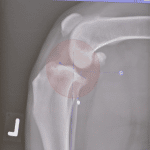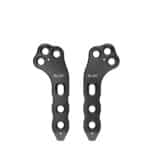Cruciate ligament rupture in cats: useful information about diagnosis and therapy

There's no shame in admitting that we cat owners sometimes get a little worried when our beloved felines limp a bit. But don't panic! In this article, we'll get to the bottom of cat cruciate ligament tears, a common cause of limping. We explain the symptoms, causes, diagnosis and treatment options to help you care for your cat.
I. Cat cruciate ligament tear: what is it?
A. Anatomy of the cat knee
Before we delve into the details of the cat cruciate ligament tear, we should first look at the anatomy of the cat knee. The knee joint connects the thigh bone (femur) and the shinbone (tibia) and is stabilized by various ligaments, including the anterior and posterior cruciate ligaments.
B. The cruciate ligament: what is it?
The anterior cruciate ligament, which is of particular interest in this article, is a strong ligament that connects the shinbone and femur. It prevents the shinbone from slipping forward during movement.
C. What happens if a cruciate ligament tears?
A cruciate ligament rupture in cats means that the anterior cruciate ligament is completely or partially torn. This leads to instability of the knee joint, pain and inflammation.
II. Symptoms and causes
A. Typical signs of a cruciate ligament rupture in cats
A cruciate ligament rupture in cats manifests itself through various symptoms. The most common signs are:
- Sudden limping or lameness of the affected leg
- Pain and swelling in the knee joint
- Limited mobility of the affected leg
- Hesitation to jump or run
B. Possible causes of a cruciate ligament rupture
A cruciate ligament tear in cats can have various causes, such as:
- Traumatic injuries from falls or accidents
- Degenerative changes in the knee joint
- Obesity, which leads to increased pressure on the knee joint
- Genetic predisposition
III. Diagnosis: How do you recognize a cruciate ligament tear in cats?
A. Veterinary examination
Diagnosing a torn cruciate ligament in cats begins with a thorough veterinary examination. The vet will feel the affected leg and look for pain, swelling and restricted movement. He will also check the so-called drawer signal , in which the shinbone is pushed forward to assess the instability of the joint.
B. Imaging procedures Cruciate ligament rupture cat
To reliably diagnose a cruciate ligament tear in cats, imaging techniques such as X-rays or ultrasound can be used. These procedures make it possible to assess the condition of the joint and surrounding structures and rule out other possible causes of the symptoms.
C. Differential diagnosis of cruciate ligament rupture in cats
Since the symptoms of a cruciate ligament tear in cats can also be caused by other diseases such as osteoarthritis, infections or tumors, it is important to rule out these diseases during diagnosis.
IV. Treatment options
A. Conservative therapy torn cruciate ligament in cat
Not all cruciate ligament tears in cats require surgery. For milder cases, conservative therapy may be sufficient, including:
- Pain management and anti-inflammatory drugs: Painkillers and anti-inflammatory medications can help relieve discomfort and reduce inflammation in the joint.
- Physical therapy: Physical therapy can help improve mobility in the affected leg and strengthen surrounding muscles to stabilize the joint.
B. Surgical Options Cruciate Ligament Tear Cat
In more severe cases or when conservative therapy is unsuccessful, surgery may be necessary. There are several surgical procedures to treat a torn cruciate ligament in cats, including:
- Extracapsular Stabilization or Intracapsular Methods : In this technique, an artificial band is placed around the knee joint to replace the torn cruciate ligament and stabilize the joint.
- Tibial Plateau Leveling Osteotomy (TPLO) : TPLO surgery involves changing the angle of the tibia to replace the function of the cruciate ligament and keep the knee joint stable.
C. Postoperative care cat cruciate ligament rupture
Postoperative care is crucial to the success of the treatment. This includes:
- Pain management and medication administration
- Limited activity and slow recovery of movement
- Physiotherapy to strengthen muscles and improve mobility
- Regular follow-up visits to the vet
V. Frequently asked questions - FAQs
Can my cat walk normally again after a torn cruciate ligament?
Yes, most cats can walk normally again after successful treatment for a torn cruciate ligament. However, recovery can take several weeks to months and requires patience and consistent follow-up care.
How long does recovery take after cruciate ligament surgery?
Recovery from cruciate ligament rupture surgery in cats can range from six weeks to several months. The exact duration depends on the severity of the tear, the surgical technique chosen and consistent follow-up care.
Can cruciate ligament tears in cats be prevented?
Although it is difficult to completely prevent cruciate ligament tears in cats, some measures can reduce the risk, such as:
B.: - Weight control to avoid excessive stress on the joints
- Regular exercise to strengthen the muscles and joints
- Avoid traumatic injuries through supervision and careful handling
VI. Conclusion
A torn cruciate ligament in cats can lead to significant pain and limited mobility. However, with early recognition of symptoms, careful diagnosis, and appropriate treatment, most cats can return to a normal life. As a responsible cat owner, it is important to be aware of this condition and take appropriate measures to provide your cat with the best possible care.






